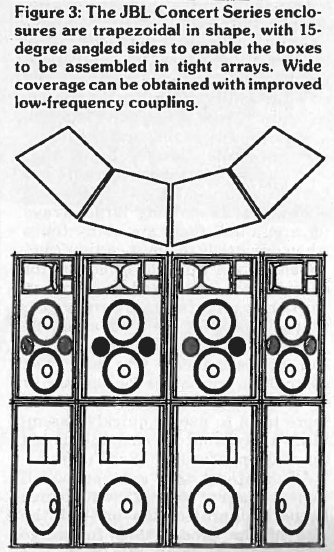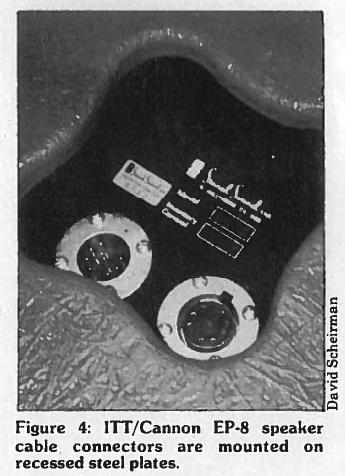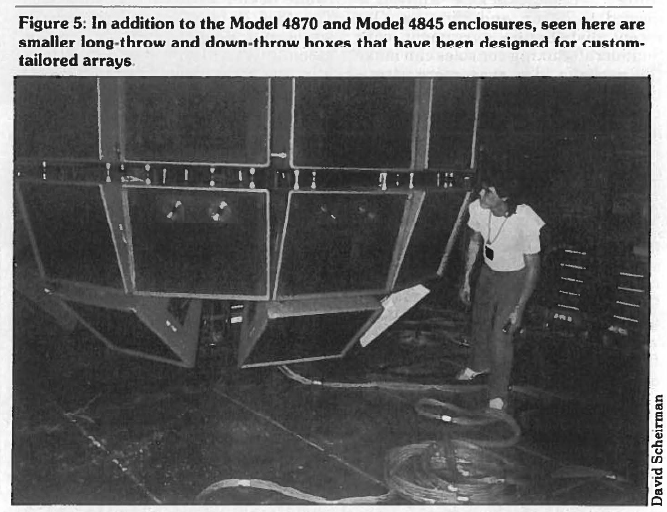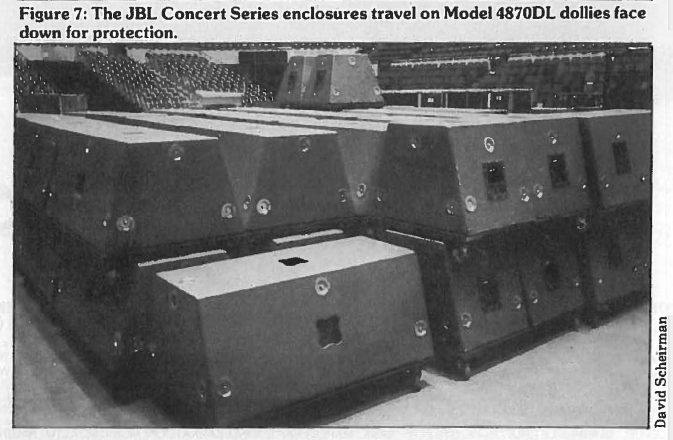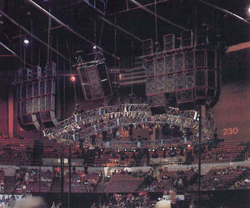
Loudspeaker Enclosures
The JBL Concert Series Model 4870 is a bi-amplified speaker system comprising dual l5-inch Model 2225H loudspeakers in a ported enclosure tuned to 40 Hz. The large circular ducts incorporated into the box design allow complete freedom from vent compression over the cabinet’s operating range (Figure 1, below).
A Model 2380 Bi-Radial flat-front horn loaded with a Model 2445J two-inch compression driver provides mid/high frequency coverage beyond 16 kHz. For systems requiring increased high-frequency power above 10 kHz, mounting provision and wiring are included for adding a pair of JBL Model 2404 ultra-high frequency transducers. Cover plates for these extra mounting holes and wiring for the tweeters are standard.
The sides of each enclosure taper from front to back at a 15-degree angle. Fourteen system hanging points with Aeroquip hardware are included on each box. These points are stress-rated between 2,000 and 5,000 pounds each, depending on the angle of pull. Each Model 4870 box weighs 214 pounds and measures 49.5 by 29,5 by 19.75 inches (HxWxD).
Coverage angles are said to be 90 degrees horizontal by 40 degrees vertical, with a frequency response of 35 Hz to 20 kHz (-10 dB). The cabinets are externally finished with a dark gray, impregnated fiberglass-reinforced plastic, A black nylon protective grill completes the package.
With a 20 to 800 Hz usable frequency range, the Concert Series Model 4845 cabinet is a very low frequency companion piece to the Model 4870. It also has identical exterior dimensions, and houses a single Model 2245H 18-inch loudspeaker in an enclosure tuned to 27 Hz (Figure 2).
The enclosures are designed to a trapezoidal pattern that allows several boxes to be assembled into tight clusters for wide-angle coverage, a configuration that also improves the coupling at low frequencies (Figure 3). The integral certified hanging points enable the quick and easy assembly of cluster arrays.
Array Assembly
The enclosures are supplied with ITT/Cannon EP-8 type connectors, one each male and female, mounted on recessed steel plates for protection (Figure 4). Every loudspeaker enclosure is equipped with aircraft-style pan fittings that terminate in a round-head stud.
Designed by Stanal Sound, the mating hardware for rigging and hanging is available to purchasers of the new JBL cabinets. The entire system has been designed with both the structural integrity and sonic characteristics of large-scale arrays in mind.
“I have always felt that the all-in-one composite speaker boxes that were common 10 years ago were not the ultimate solution,” Miller explains. “In assembling large arrays for arena use, there are many times when one needs to point certain components in a specific direction for optimum coverage. We have come up with a ring and stud hardware system that gives one the ability to assemble very sturdy clusters that, if so desired, can be permanent.
“Our half-sized companion enclosures for long-throw and down-throw applications give us more tools to use in quickly assembling arrays that are custom-tailored for each specific use.” (Figure 5)
JBL’s Model 4866 cabinet, which houses a pair of Model 2386 40-degree horns, is approximately one-half the size of the Model 4870 full-range enclosure. A small mid/high box (Model 4860) and bass box (Model 4847) are also available (Figure 6).
According to Miller, the Concert Series enclosures were stress-tested before the box designs and construction techniques were finalized. “Whenever you suspend anything in the air above people’s heads, safety is the prime consideration. The structural engineering is just as critical as the audio; a mechanical system is only as strong as its weakest link, We have designed this system to have no weak links.” (See accompanying sidebar titled Stress-Testing the Hanging System—Editor.)
The modular speaker boxes are easily transported on a specially designed dolly (JBL Model 4870DL). For protection, the boxes travel face down (Figure 7). When portable systems are transported by truck, the boxes can be stacked up to four high.
Stanal On Tour
In December 1985, Stanal took the first full-scale Concert Series arena system on tour with Neil Diamond. The brief tour played to capacity crowds in such venues as Kemper Arena (Kansas City), Riverfront Coliseum (Cincinnati), and Joe Louis Arena (Detroit).
A total of 64 Model 4873 enclosures (three-way versions of the Model 4870) were suspended in the flying array. Additionally, 32 Model 4866 long-throw packages and Model 4860 down-throw packages were carried. Subwoofer enclosures were placed at floor level.
Of specific interest with Stanal’s arena array configuration for Neil Diamond were two additional clusters to supplement the main left and right hanging groups: eight Model 4873 boxes were suspended above the center-stage line, and angled downward into the forward seating sections; another separate cluster was suspended behind the stage to provide optimum sound coverage for the rear seating areas.
The two main speaker arrays were fed discrete left and right stereo program material, while the auxiliary center cluster was given a combined left/right mix. “Oftentimes in large venues, the best seats in the house have traditionally received less-than-ideal sound because of the ‘hole’ between the left and right stacks,” Miller explains. “The center cluster helps to fill that gap, and let the closer audience areas hear a true stereo mix.”


